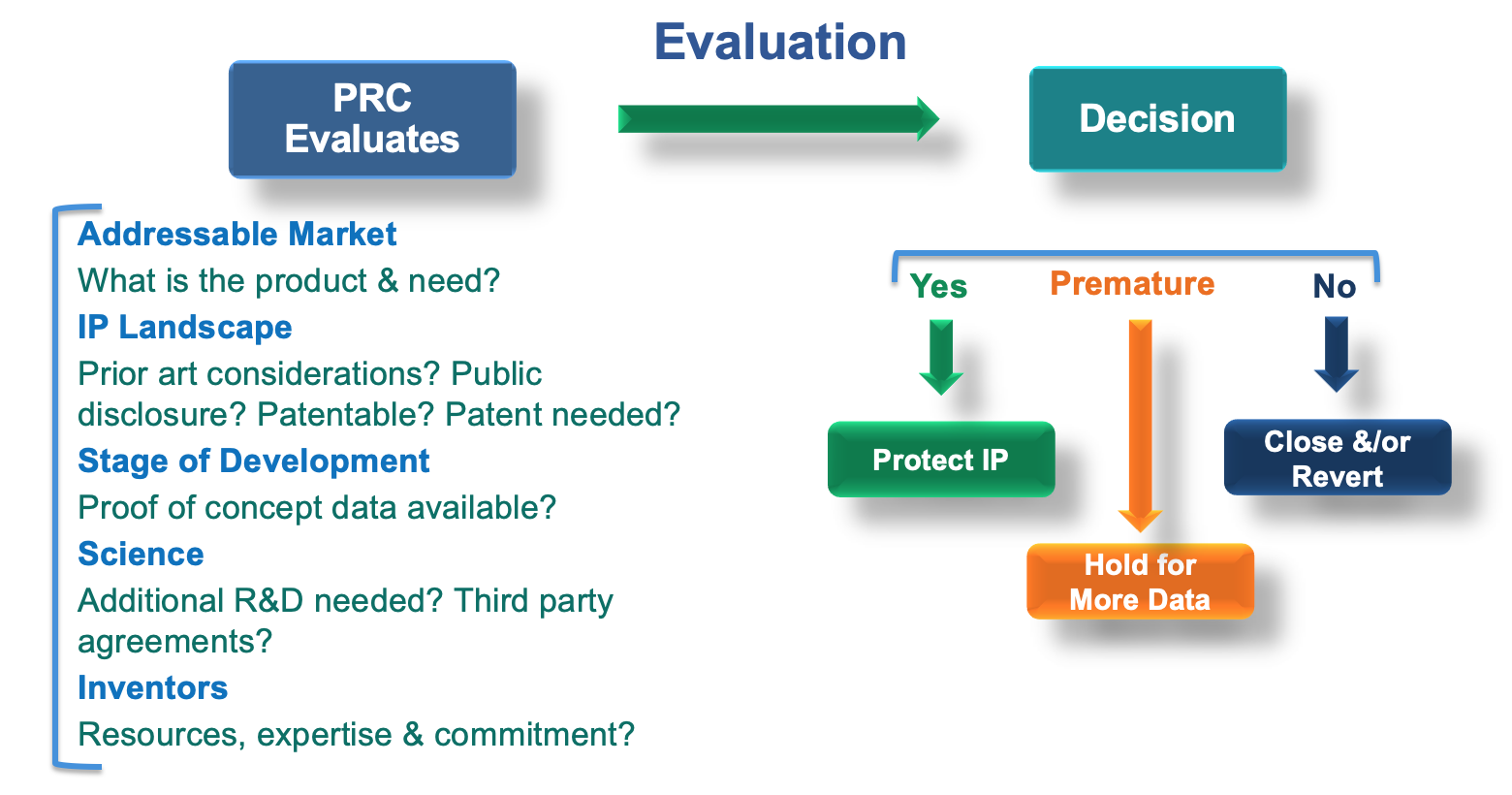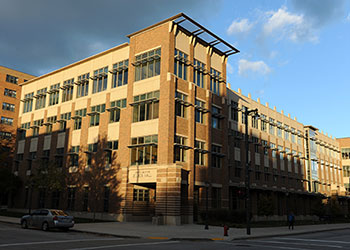What is intellectual property?
Intellectual property is a product of human innovation protected by the law from unauthorized use. Intellectual property (IP) consists of a bundle of property rights issued by the government, varying from country to country. Patents, copyrights, trademarks and trade secrets compose IP.
Types of intellectual property
Intellectual property consists of four main areas: (1) patents, (2) copyrights, (3) trademarks and (4) trade secrets. The Technology Transfer Office focuses on pursuing protection for patents and copyrights.
- A utility patent protects inventions — new and useful processes, machines, articles of manufacture, compositions of matter, or any new and useful improvement thereof. A patent protects innovation by granting the right to exclude others from unauthorized use of the invention. A patent protects an invention for 20 years.
- Copyright protects original works of authorship fixed in a tangible medium of expression. A copyright protects software, media, artistic or written works, instructional materials and more. However, copyright law does not protect ideas, systems or methods.
- A trademark is a name or symbol that identifies a product or service. To receive protection, a mark must be distinctive and used in commerce. Trademarks are protected by law for as long as the mark remains in use.
- A trade secret is information a business develops that is valuable and not widely known by others. Often, trade secrets are patentable. Protection of a trade secret persists so long as the information remains a secret.
Marquette researchers often know or develop trade secret information in the course of research. It is difficult, if not impossible, to maintain a trade secret in academia — we publish, present, patents get published, etc. and there are strict guidelines that need to be followed to prove that something had indeed been maintained as a trade secret.
The patent application process
Who can file a patent application?
Any person who “invents or discovers any new and useful process, machine, manufacture, or composition of matter, or any new and useful improvement thereof, may obtain a patent.” The inventor or an applicant to whom the inventor has assigned or is under obligation to assign the invention may apply for a patent application. A patent may only be applied for in the name(s) of the actual inventor(s).
What can be patented?
To be patentable, an invention must be:
- Patentable Subject Matter: subject matter that is eligible for patent protection under patent law. Subject matters that cannot be patented include mathematical formulas, scientific principles, naturally occurring substances, laws of nature and processes done entirely with the human body. Ideas are patent ineligible. To be patentable, the idea must be embodied in one or more of:
- A new composition of matter: e.g., a new compound
- A process or method: e.g., a new way to manufacture an article
- A machine: i.e., something with moving parts or circuitry
- A manufactured article: i.e., a tool that achieves results with few or no moving parts e.g., a pen
- An asexually reproduced and new variety of plant
- Novel: The invention must be new – it must differ from knowledge that already exists in the public domain, prior patents, published patent applications, any publication available to the public and items on sale (together referred to as “prior art”).
- Useful: Utility under United States patent law means an invention must have at least one specific use. If an invention works for its intended use, it has utility. Very few inventions fail the utility test. Under European patent law the invention must be susceptible of industrial application.
- Non-Obvious: Under United States patent law, “The subject matter sought to be patented must be sufficiently different from what has been used or described before that it may be said to be non-obvious to a person having ordinary skill in the area of technology related to the invention.” A "person having ordinary skill” is not the average person, but someone who is actually skilled in the inventive field.
What is a provisional patent application?
The provisional patent application (PPA) is a legal document filed in the USPTO that establishes the priority date for your invention while avoiding the costs associated with the filing of a nonprovisional patent application (NPA). The PPA gives inventors flexibility to quickly protect an invention and essentially provides a one-year extension as to the filing of an NPA. A PPA provides the applicant an additional year to experiment, perfect an invention, determine commercial potential, find interested parties for licensing, etc. The PPA is not examined by the USPTO. It expires if it is not converted and filed as a non-provisional patent application within one year of the provisional filing date.
Facts about a PPA from USPTO.gov:
- A PPA expires after one year.
- You cannot extend a PPA.
- You cannot renew a PPA.
- A PPA will never become a patent.
- You cannot file a PPA for a design.
- The USPTO does not examine PPAs.
- The USPTO does not conduct a prior art search on PPAs.
- The USPTO does review PPAs to make sure they meet minimum filing requirements.
- PPAs are not published by the USPTO (unless claimed as priority in a later-issued or published nonprovisional application).
- You can use the term "patent pending" for the duration of the one-year pendency of a PPA.
Converting provisional to a non-provisional application
Inventors have one year from the priority date to generate more data for the strongest possible non-provisional patent application. During this time OEE does more due diligence to assess the marketability and commercial potential of the invention. Marquette does not have the budget to convert all provisional to non-provisional applications. OEE is most likely to file non-provisional applications on inventions with:
- High likelihood of patentability
- Minimal prior art issues
- High commercial potential
- Identified potential licensees
What is a non-provisional patent application?
Although one can file a non-provisional patent application without first filing a provisional application, OEE’s practice is to first file a provisional patent application. The non-provisional patent application is the formal filing of an invention with the USPTO that forms the basis for an issued utility patent if the invention claims are allowed after being examined by the USPTO.
Parts of a non-provisional patent application
- Title
- Reference and describe related art: description of the current state of the art
- Statement of federally sponsored research or development, if any
- Names of the parties to a joint research agreement if applicable
- Background
- Field of invention: description of your invention
- Summary: objectives of your invention
- Description of drawings
- Detailed description: provides as much detail as possible on your invention, includes preferred embodiments and different embodiments
- Claims: the most valuable part of the application, typically a claim is a one-sentence recitation of your invention. Claims are exactly what the applicant owns, namely, the intellectual property on which others cannot infringe.
- Abstract
- Sequence listing if any
What is the patent process?
It is the duty of the USPTO to ensure that every patent and other intellectual property given in the name of the government is worthy of an issued patent. Every inventor must put in the work to get those rights: Know what makes your patent novel, useful and non-obvious, include prior art references in the patent application and work with OEE, patent attorney and USPTO examiner to get the claims that you need and that the USPTO will allow.
Who files the Patent Application?
Marquette engages outside patent counsel for patent application filing and prosecution to ensure access to specialists in diverse technology areas. Inventor expertise and feedback is crucial during filing and prosecution. Inventors are indispensable for obtaining meaningful patent protection – you will work closely with patent counsel in answering inventorship questions and reviewing the draft patent application. At the time of filing, inventors will sign an Inventor Declaration (an oath stating that you are an inventor) and as per Marquette’s Intellectual Property Policy, a notarized Assignment under which you, the inventor(s) assign your rights in the patent to Marquette.
Patent Prosecution
The patent process can be thought of as a negotiation – together, the goal of the inventors and patent counsel is to persuade the examiner to allow your claims. Within 12 to 24 months of filing a nonprovisional patent application, your first non-final Office action will include rejections of most, if not all, of your claims because the claims are not patentable over the prior art. A patent examiner writes this Office action document that cites prior art and gives reasons as to why the examiner has rejected and/or allowed the applicant’s claims. In certain cases, the examiner may issue a Restriction Requirement if they think your claims cover multiple inventions, segregating claims into groups and requiring you to elect one group of claims for initial examination.
The patent attorney must file a written response with inventor input by providing counterarguments as to why the examiner position is believed to be incorrect and/or amending the claims to include features that are not disclosed or suggested in the cited prior art. This procedure is referred to as patent prosecution. During prosecution, inventor input is critical to confirm the patent attorneys’ understanding of the technical aspects of the invention and/or the prior art cited against the application.
It typically takes several Office actions and responses and 2-5 years before the application is resolved. If the examiner is not convinced by your responses to non-final Office actions, they will issue a final Office action. The applicant has the option to file a further response that would result in another non-final Office action. The resolution can result in a final rejection or USPTO notice of allowance stating that the application and prosecuted claims will issue as a patent.
How much do patents cost?
U.S. patents
Patent costs are uncured for preparing a patent application for filing and prosecution. Preparation includes everything until the formal filing. Prosecution includes costs for everything from filing to issuance of the patent. Between USPTO filing fees and associated attorney costs, the U.S. average for filing a patent application is $12,000. Prosecution can cost $40,000 to $50,000 – the total cost of an issued U.S. patent is $50,000 to $60,000. An issued U.S. patent is one of the best bargains, since a single patent may cost $60,000 but covers a population of 300+ million. It may cost 10 times as much to cover the same population in Europe.
International patents
International patent filings are typically managed by filing a Patent Cooperation Treaty (PCT) application. An advantage to filing a PCT application is it delays the filing of costly foreign applications until 30 months after the provisional filing date. This gives us time to further develop, market and license the invention. We must choose within 18 months of the PCT filing, which of the 190 PCT countries in which to file national phase applications. Foreign filings are expensive due to translation costs and because foreign attorneys need to be engaged. A multination filing can easily cost well over $100,000. Annual maintenance fees for all pending applications and issued patents adds to the total cost over the lifetime of a patent. Decisions to file international patent applications must thus be made judiciously and hopefully with input from a licensee about their global business strategy and needs.
Who pays for patent costs?
For those technologies disclosed to OEE that are pursued after the evaluation process, Marquette pays patent filing, prosecution and maintenance costs until such time as a licensee is identified. After the technology is licensed, OEE will typically seek reimbursement of past and ongoing patent costs from the licensee.
What right is conferred by a patent?
The right conferred by an issued patent is “the right to exclude others from making, using, offering for sale or selling” the invention in the United States or “importing” the invention into the United States.


